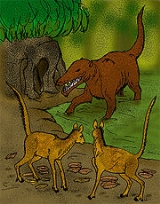
Diacodexis
Encyclopedia
Diacodexis is an extinct genus of small herbivore
mammal belonging to the family
Dichobunidae
which lived in North America
and Asia
from 55.4 mya—46.2 mya. and existing for approximately .
It is the oldest known even-toed ungulate
. In life, it would have resembled a modern duiker
, measuring about 50 centimetres (1.6 ft) in body length, but with a much longer tail. Unlike most later species of artiodactyl, it still had five toes on each foot, although the third and fourth toes were already elongated. It may also have had small hooves on each toe. Its teeth suggest that it was a herbivorous browser.
As suggested by its long legs, Diacodexis is believed to have been fast-running, capable of leaping relatively far.
Herbivore
Herbivores are organisms that are anatomically and physiologically adapted to eat plant-based foods. Herbivory is a form of consumption in which an organism principally eats autotrophs such as plants, algae and photosynthesizing bacteria. More generally, organisms that feed on autotrophs in...
mammal belonging to the family
Family (biology)
In biological classification, family is* a taxonomic rank. Other well-known ranks are life, domain, kingdom, phylum, class, order, genus, and species, with family fitting between order and genus. As for the other well-known ranks, there is the option of an immediately lower rank, indicated by the...
Dichobunidae
Dichobunidae
Dichobunidae is an extinct family of early even-toed hoofed mammals known from the early Eocene to late Oligocene of North America, Europe, and Asia. Dichobunidae includes some of the earliest known artiodactyls, such as Diacodexis....
which lived in North America
North America
North America is a continent wholly within the Northern Hemisphere and almost wholly within the Western Hemisphere. It is also considered a northern subcontinent of the Americas...
and Asia
Asia
Asia is the world's largest and most populous continent, located primarily in the eastern and northern hemispheres. It covers 8.7% of the Earth's total surface area and with approximately 3.879 billion people, it hosts 60% of the world's current human population...
from 55.4 mya—46.2 mya. and existing for approximately .
It is the oldest known even-toed ungulate
Even-toed ungulate
The even-toed ungulates are ungulates whose weight is borne about equally by the third and fourth toes, rather than mostly or entirely by the third as in odd-toed ungulates such as horses....
. In life, it would have resembled a modern duiker
Duiker
A duiker is any of about 21 small to medium-sized antelope species from the subfamily Cephalophinae native to Sub-Saharan Africa.Duikers are shy and elusive creatures with a fondness for dense cover; most are forest dwellers and even the species living in more open areas are quick to disappear...
, measuring about 50 centimetres (1.6 ft) in body length, but with a much longer tail. Unlike most later species of artiodactyl, it still had five toes on each foot, although the third and fourth toes were already elongated. It may also have had small hooves on each toe. Its teeth suggest that it was a herbivorous browser.
As suggested by its long legs, Diacodexis is believed to have been fast-running, capable of leaping relatively far.
Morphology
Fossil specimens of four individuals' body mass were examined by Legendre and Roth.- Specimen 1: 3.22 kg (7.0 lb).
- Specimen 2: 2.89 kg (6.3 lb).
- Specimen 3: 2.62 kg (5.7 lb).
- Specimen 4: 2.24 kg (4.9 lb).

